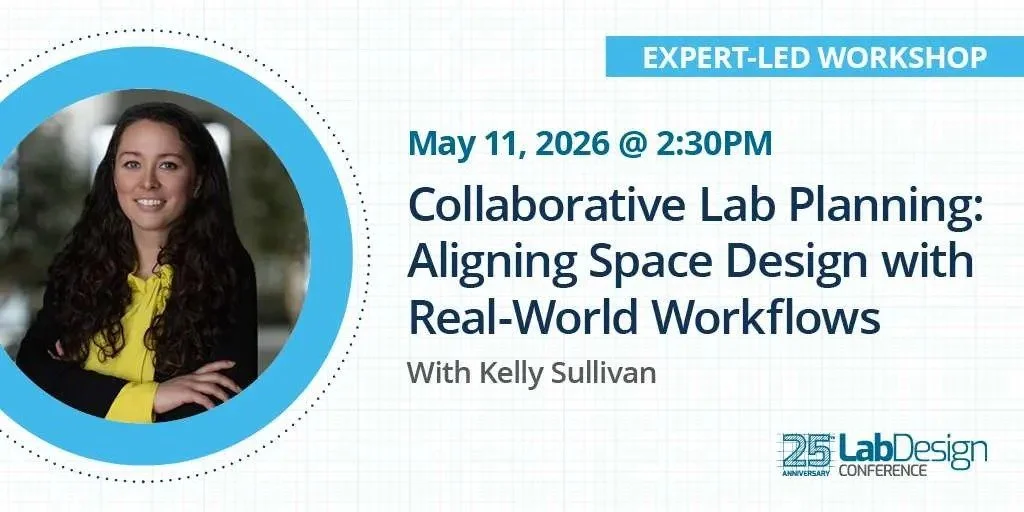Lab Design Conference Speaker Profile: Kelly Sullivan, PhD
Kelly Sullivan, PhD, global director of operations & labs at CIC, will lead a hands-on workshop titled “Collaborative Lab Planning: Aligning Space Design with Real-World Workflows” at the 2026 Lab Design Conference in Orlando, FL. Scheduled for May 11, 2026, from 2:30–4:30 pm ET, this interactive session will explore strategies for aligning laboratory design with real-world scientific processes.
Through guided exercises and planning scenarios, participants will learn how to translate operational needs—such as safety, storage, and collaboration—into design solutions that promote flexibility, functionality, and strong communication between users and designers. This workshop is ideal for lab leaders, end users, designers, safety professionals, real estate representatives, and suppliers seeking to create safer, more efficient, and future-ready lab environments.
Seats for this workshop are limited and must be purchased in addition to your Lab Design Conference ticket. Register before December 31, 2025, to take advantage of early-bird pricing for your full conference ticket.
Lab Design News spoke with Kelly about the future of lab design, practical upgrades for existing spaces, and the lessons that have shaped her approach to planning. Read more about her insights and register today to secure your spot for her workshop—space is limited!
Q: What makes your Lab Design Conference workshop especially relevant to the current trends and challenges in laboratory design?
A: Labs today are complex, collaborative environments. My workshop focuses on how to align lab spaces with the science happening inside them. We’ll bridge the gap between users and designers by translating real workflows, safety, storage, and collaboration into clear planning strategies. The goal is to design labs that are flexible, functional, and built for the future.
Q: What key takeaways should attendees expect from your workshop, and how can they apply these insights in their own labs?
A: You’ll learn how to map scientific workflows, define shared and private zones, and identify flexibility needs early in planning. We’ll also cover strategies for planning your lab using established decision-making frameworks. Together, we’ll practice communication tools that align users, designers, and project teams. Everything you learn can be applied immediately, whether you’re refining an existing lab or planning a new one.
Learn how to optimize your lab space in Kelly’s free on-demand webinar, “Designing Shared Lab Spaces: Balancing Functionality, Collaboration, and Future-Proofing,” which qualifies for 1 AIA learning unit.
Q: How do you see the future of lab design evolving over the next five to 10 years, and how should professionals prepare?
A: Lab design is moving toward adaptability and connection. Research is faster and more cross-functional than ever, and spaces must evolve just as quickly. The most successful professionals will be those who can facilitate collaboration, plan for flexibility, and build environments that support both innovation and continuity.
Q: What practical tips can lab users apply to optimize their current space, without a major renovation or rebuild?
A: Start with what’s in your control. Act like a scientist, gather data by observing how people move, share equipment, and store materials. Use this data to streamline safety and storage, clarify zones, and make workflows visible. Small, thoughtful changes like modular shelving or improved equipment placement can significantly increase efficiency and team ownership without a major renovation.
Q: What’s one lesson from a past project that significantly influenced your approach to lab design?
A: I worked on a project where layouts were finalized before talking to the scientists. It looked perfect on paper but didn’t fit how people actually worked. The space was so tightly packed with equipment that there was barely room to function, and not even a biohazard bin could fit inside the lab once it was built. That experience cemented my belief that labs must be designed with users, not just for them. Every strong design starts with listening and shared understanding.
Reserve your seat in Kelly’s workshop today! Visit the Lab Design Conference website for full event details.

